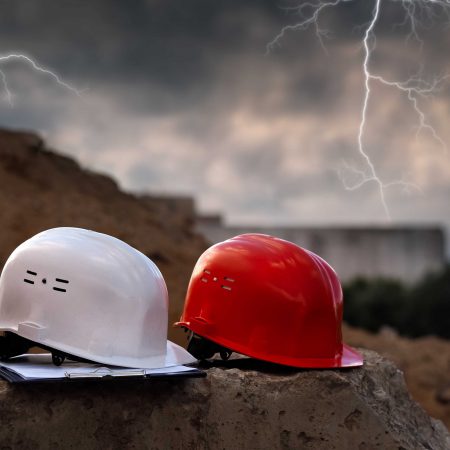Preparing a Construction Site for a Hurricane
Extreme inclement weather that resulted in excessive flooding in South Florida recently, coupled with the beginning of hurricane season on June 1, requires all of us to take stock in preparing for what may lie ahead both personally and professionally.
In commercial real estate that necessitates a well thought out plan and strategy outlined in advance. South Florida general contractors with years of experience and success protecting construction sites and their clients’ assets are well equipped to handle any type of weather-related situation. Those with an established regional presence and a reputation for quality craftsmanship, like Excel Construction of Florida, work with a different mindset, especially during hurricane season, putting in place safeguards well in advance that prevent damage and project delays.
Preparing a Construction Site for High Winds
As Benjamin Franklin once said, “By failing to prepare, you are preparing to fail.” Diligent general contractors know that planning ahead is the key to a project’s success and on-time delivery. Advanced planning improves efficiency, saves money and protects a project’s value.
The good news is that compared to other forces of nature hurricanes are anticipated in South Florida each year, and when one is looming off the coast there is generally still time for last-minute preparations. Those general contractors in the know recognize that as June 1 approaches their mindset needs to shift drastically. Equipment and supplies should be positioned differently from the start of the season so that crews aren’t working stressfully at the last minute to protect valuable property and equipment.
Positioning a generator onsite prior to hurricane season is sensible planning should electricity be lost for any amount of time after the storm or hurricane passes. Remember to have gasoline on hand to power generators in the aftermath.
Long before the storm clouds roll in, construction sites should be adequately monitored for potential hazards, kept clean and organized with loose items stored at a secure location. This could be in a heavy storage container on-site, the interior of an unfinished building or potentially an off-site office, garage or warehouse. Piles of granular materials such as sand, gravel, stones and woodchips should remain tightly covered and tethered with a tarp that can’t easily blow away.
As wind speeds in a storm increase, loose objects on a site, such as nails, screws, bricks, tools, glass and more, could potentially become airborne as dangerous projectiles. This is hazardous not only to your construction site, but to the surrounding area as well, where nearby properties can take a hit because of loose items left on your site.
Strong gusts of wind can also knock over portable restrooms or even trailers. This type of equipment needs to be positioned well in advance in a safe and protected location. If there is fencing surrounding the job site and it is not securely fastened to the ground, it may need to be removed before a storm makes landfall to protect neighboring structures and the environment.
If you are building in an area that has trees or canals, consider how best to protect the site from toppled trees and flooding, but also consider how to best protect the surrounding environment from falling victim to unnecessary flying debris and hazardous materials.
If any hazardous materials or chemicals, including gasoline and other liquids, are stored on-site, winds could knock containers over and cause a leak, creating a health and environmental concern. Remove these barrels from the path of the storm.
Tall cranes are particularly worrisome and difficult to relocate or retract due to their size, which is why consideration of placement should be top-of-mind as hurricane season approaches. Cranes can be weather-vaned so that its slew or parking brake can be released, allowing the crane to rotate 360 degrees with the natural direction of the wind. Any objects the crane is holding, such as steel beams, timber or a wrecking ball, need to be removed so nothing swings and crashes into surrounding structures.
Preparing a Construction Site for Heavy Rain and Flooding
The location of a construction site also determines how to prepare for heavy rain and potential flooding. Low-lying areas are at an increased risk. If your project is near the coastline, it is more likely to be more heavily impacted than if it were inland, but the eye of the storm does sometimes hit inland areas as well as evidenced by Hurricane Charley ripping through Central Florida in 2004.
Prior knowledge of your flood zone is extremely important and will determine the level of risk. Given the nature of an in-progress project, there may not yet be a working drainage system in place and rain could make the site messy. An alternative should be determined in advance based on your site, capabilities and risk.
Skilled general contractors who use innovative technology to monitor and control their many job sites can account for the unique aspects of each project and ensure that safety precautions individual to each job don’t slip through the cracks.
Depending on the stage your project is in, doors, windows and a roof may not have been installed yet, which leaves a structure very vulnerable in a hurricane. Cover openings with a secure tarp or board them up with wood planks to prevent water and debris from flowing in and causing damage. Remember to turn off all electricity prior to a storm to reduce or eliminate any risk.
Recovery Efforts After a Hurricane
Just because a storm has passed and the skies are clear and sunny, does not mean a construction site is safe. Caution is still mandated.
Before crews return to work, make sure to do a safety evaluation of the site. Be mindful of downed powerlines as it may be difficult or impossible for workers to see a live wire underwater. Watch for sharp items and other debris, such as glass and metal objects, that can cause serious injury, become tripping hazards and or may have shifted and are in danger of falling. Also, take inventory of the site, noting any materials that are missing or destroyed.
Construction Site Safety Best Practices
At Excel Construction of Florida, the safety and wellbeing of our crew is our top priority. We hire an outside agency to hold us accountable and make sure safety standards are upheld and adhered to. A third-party professional routinely comes to survey our sites to ensure that proper safety and training measures are being addressed. That inspector provides guidance on how to make those improvements.
As a relationship-driven company that has established long-term partnerships built on respect and integrity, minimizing risk to our valued clients is also top of mind. We are committed to delivering on our promise to “Stand for What Counts,” and this includes safeguarding the environment, the communities that surround each of our projects and our promise to complete each job efficiently.
The safer a construction site is kept daily in good weather, the easier it will be to prepare for inclement weather, particularly storms and hurricanes.
Be prepared because you can never be too safe.























